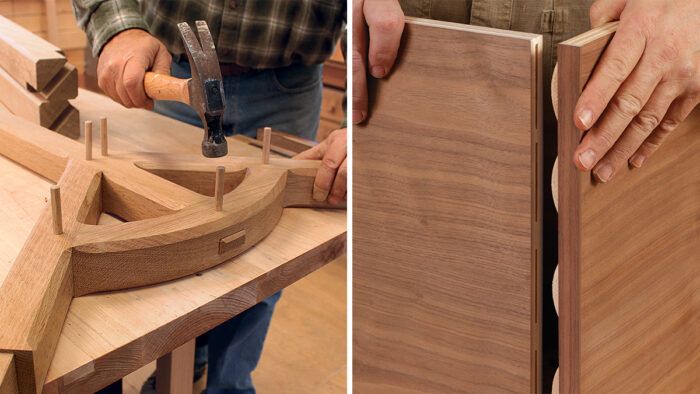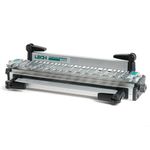All About Dowels and Biscuits
Mario Rodriquez explains why dowels and biscuits are adequate substitutes for more traditional joinery techniques.

Relatively speaking, dowels and biscuits are modern innovations in joinery that have come about with the invention of power tools and jigs. As mechanical means of joining two boards, they are adequate substitutes for more traditional joinery techniques.
The Basics:
- The dowel: Cylindrical pieces of wood are used to join two workpieces.
- The biscuit: A thin football-shaped disk is used to join two workpieces.
The dowel
Dowels are wooden cylinders that fit into holes that are drilled into both workpieces. When the parts are assembled, they form a strong joint. Basically, dowels are a substitute for a mortise-and-tenon joint.
Dowels range in diameter from 3/16 in. to 1 in. and can be purchased at any home center or lumberyard, or produced from scratch. As a rule, the diameter of the dowel should equal 1/3 the thickness of the material. The minimum length should be at least 1-1/2 times the diameter. The number of dowels needed is determined by the width of the board, divided by the thickness. Dowels must fit tightly in the hole, and should be slotted, along their length, to allow excess glue to escape.
For dowels to provide strength and give the joint a good appearance, the holes must be registered accurately. Any offset or misalignment of the holes will prevent the joint from coming together properly or might cause the assembled joint to split.
There are several jigs on the market that ensure accuracy. Each type operates differently, but they all use bushings of various diameters. These bushings are positioned along the length or thickness of a board, to guide a drill bit at 90° to the wood surface.
The dowel was around long before it was used strictly as a mechanical joint. However, its historical use has been to pin traditional joints such as mortise-and-tenon joints and specialty joints.
The biscuit
The Swiss company Lamello can be credited for bringing the biscuit joint to the masses. The introduction of its portable plate joiner, more commonly known as a biscuit joiner, allowed this modern technique for joining two parts to be used by hobbyists and professionals alike.
A biscuit (or plate) is a thin, football-shaped disk that works much like a floating tenon. Matching slots are cut into two workpieces, with each slot accepting half of the biscuit. When glue is applied to the joining parts, the biscuit expands in the slots and creates a tight-fitting joint.
Biscuits come in different sizes and are now made of different materials including plastic and metal. Their use depends on the materials being joined and the application.
Fine Woodworking Recommended Products

Leigh Super 18 Jig

Olfa Knife

Freud Super Dado Saw Blade Set 8" x 5/8" Bore








Comments
I still argue with people who insist "Biscuits are for alignment only." I've made about 50 bookcases 7' tall, plus some cabinets, that are held together with biscuits only. No failures in 30 years. I do not use them ever for edge joining where their strength is superfluous. Are they the strongest joint, no. Are they strong enough for the application, yes.
I do believe they are stronger than dowel joints, especially after a few seasons of expansion/contraction. https://www.finewoodworking.com/1980/04/01/the-dowel-joint
Log in or create an account to post a comment.
Sign up Log in